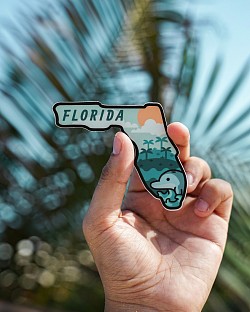My Top Rockhounding Spots in Florida
Guide for Rockhounders
Top Rockhounding Locations in Florida
Gandy Beach
Location: Tampa Bay area
Finds: Quartz crystals, agatized coral, fossilized remnants
Description: An ecological masterpiece featuring mangrove forests and shallow water bodies, Gandy Beach offers a diverse range of geological finds for enthusiasts.
Key West
Location: Southernmost tip of the United States
Finds: Agatized corals, colored sea glass, sponge coral fossils, jasper
Description: Known for its unique geological features and diverse ecosystem, Key West is a treasure trove for rockhounds seeking rare specimens.
Venice Beach
Location: Gulf Coast
Finds: Shark teeth, fossils
Description: Famous for its abundance of shark teeth and other fossils, Venice Beach is a popular destination for fossil hunters.
Ruck’s Pit
Location: Fort Drum
Finds: Agatized coral, fossils
Description: Renowned for its calcified clams and other unique fossil finds, Ruck’s Pit attracts collectors interested in distinctive specimens.
Englewood Beach
Location: Gulf Coast
Finds: Fossilized coral, shark teeth, sponges, manatee bones
Description: This beach offers a variety of fossilized finds along its shores, appealing to a wide range of rockhounding interests.
Hillsborough River
Location: Central Florida
Finds: Brain coral, finger coral, agate
Description: A prime location for discovering various types of coral and agate, Hillsborough River is favored by collectors.
Dunedin
Location: Gulf Coast
Finds: Coral geodes
Description: Known for its unique coral geodes, Dunedin provides rockhounds with opportunities to find rare and beautiful specimens.
Gandy Beach Mangroves, FL
Rockhounding Guide: Exploring Gandy Beach Mangroves
Introduction to Rockhounding
• Rockhounding, the hobby of collecting rocks, minerals, gemstones, and fossils, has grown significantly in popularity over the years.
• Among Florida's many sites, Gandy Beach Mangroves stands out as a relatively unexplored location, offering spectacular specimens and a memorable experience.
• This guide provides a comprehensive overview of rockhounding at Gandy Beach Mangroves, Florida.
Environmental Setting
• Situated in the greater Tampa Bay area, Gandy Beach Mangroves is an ecological gem known for its scenic beauty and abundance of mineral-rich deposits.
• The area features dense mangrove forests interwoven with shallow water bodies, creating a delicate balance of flora and fauna that supports a vibrant ecosystem.
Geological Highlights
• For geology enthusiasts and mineral collectors, Gandy Beach Mangroves represents a largely untapped resource.
• The erosion caused by ocean tides combined with mineral-rich sediments offers a diverse array of geological finds.
• Notably, the site is famous for quartz crystals, agatized coral, and various fossilized remnants that reflect Florida's ancient geological past.
Essential Equipment
• Before embarking on a rockhounding adventure here, it is crucial to be well-prepared with the right equipment.
• Recommended tools include a rock hammer, hand lens, geologist’s pick, field bags, safety glasses, a first-aid kit, and appropriate clothing.
• These items ensure effective excavation and personal safety during your exploration.
Legal and Ethical Considerations
• Successful rockhounding requires more than just tools; it demands respect for legal boundaries.
• Adhering to Florida's Hobbyist Collection and Surface Collection Laws is essential to preserve the practice for future generations.
• Responsible and ethical collection methods help maintain the site's integrity and ecological balance.
Further Exploration
• Rock Varieties and Geological Composition
-to Discovering Key West
Unearthing Geological Treasures: Rockhounding in Key West
Introduction to Rockhounding and Key West
In today's urbanized world, the natural beauty of the earth's gifts is often overlooked. However, there remain passionate individuals known as rockhounds who dedicate themselves to discovering geological treasures. Acting like detectives, these enthusiasts explore nature in search of unique rocks, minerals, and fossils. One particularly fascinating destination for rockhounding is Key West, Florida. This guide offers an insightful perspective on how to uncover geological gems in Key West, a paradise still unknown to many rockhounds.
Key West's Allure for Rockhounds
Located at the southernmost tip of the United States, Key West attracts rockhounds with its distinctive geological features and rich, diverse ecosystem. Its strategic position, surrounded by the Gulf of Mexico and the Atlantic Ocean, enhances its appeal. Known as the Conch Republic, this island city breathes new life into the practice of rockhounding, offering unique opportunities for collectors and enthusiasts alike.
Beachcombing for Treasures
Key West’s shallow sandbars and beaches provide excellent starting points for both novice and experienced rockhounds. The tides frequently wash ashore fascinating specimens, including agatized corals and colorful sea glass. Regular walks along popular spots such as Smathers Beach, Higgs Beach, or Dry Tortugas Beach can yield rewarding discoveries for those with a keen eye.
Exploring Fort Jefferson and Surrounding Islands
Fort Jefferson, often called the "Gibraltar of the West," located within Dry Tortugas National Park, is another prime location for rockhounding. The protective barrier reefs surrounding the fort may conceal more than just marine life. With careful planning and adherence to safety measures, the rubble outcrops around the fort and nearby remote islands—Logan, Bush, and Long Key—offer potential finds such as sponge coral fossils and jasper, making these areas a treasure trove for dedicated collectors.
Historical and Geological Context
Understanding Key West’s geology also involves appreciating its rich history. Before European explorers arrived, the area was inhabited by the Calusa Indians. Their tools, often crafted from chert, along with discarded shells, can sometimes be uncovered during inland hikes or fossil expeditions. These artifacts provide a fascinating glimpse into the region’s past and add depth to the rockhounding experience.
Environmental and Cultural Responsibility
While searching for geological treasures, rockhounds must remain mindful of their environmental and cultural impact. Disturbing historical artifacts or damaging the delicate coastal ecosystem can cause irreversible harm. Responsible collecting practices and respect for protected areas are essential to preserving Key West’s natural and cultural heritage for future generations.
Developing Rockhounding Skills
Successful rockhounding requires patience, keen observation, and perseverance. It is not an activity that yields instant rewards but rather a rewarding journey of discovery. Learning about Key West’s geological history and understanding how natural forces like wind, tides, and human activity influence mineral distribution can greatly enhance a rockhound’s ability to locate valuable specimens.
Conclusion: A Journey of Discovery
Key West, with its pristine beaches, rich history, and unique geographical location, offers abundant opportunities for passionate rockhounds. It invites those who look beyond the surface to embark on a journey that reveals the earth’s ancient stories through its geological treasures. The true adventure begins when you step onto the sandy shores, equipped and ready to explore, as you start your own chapter of discovery in this remarkable paradise.








